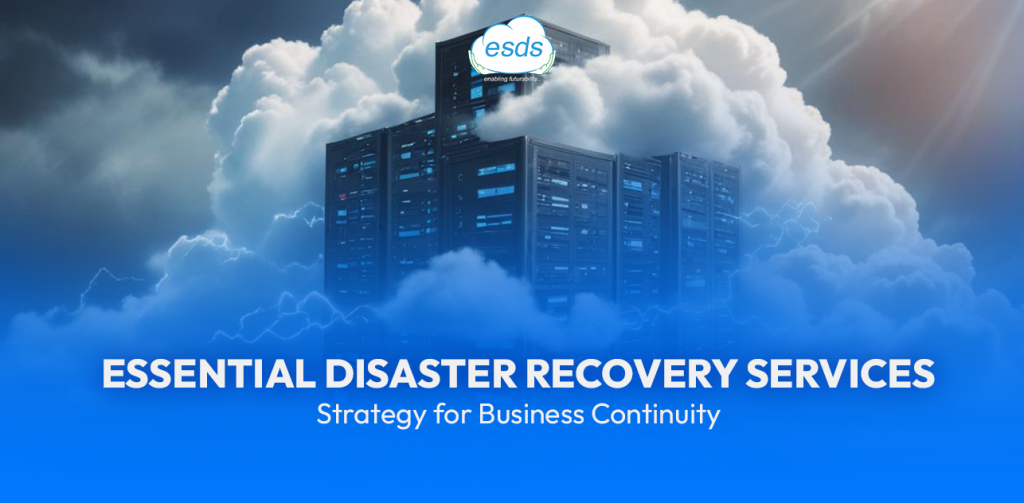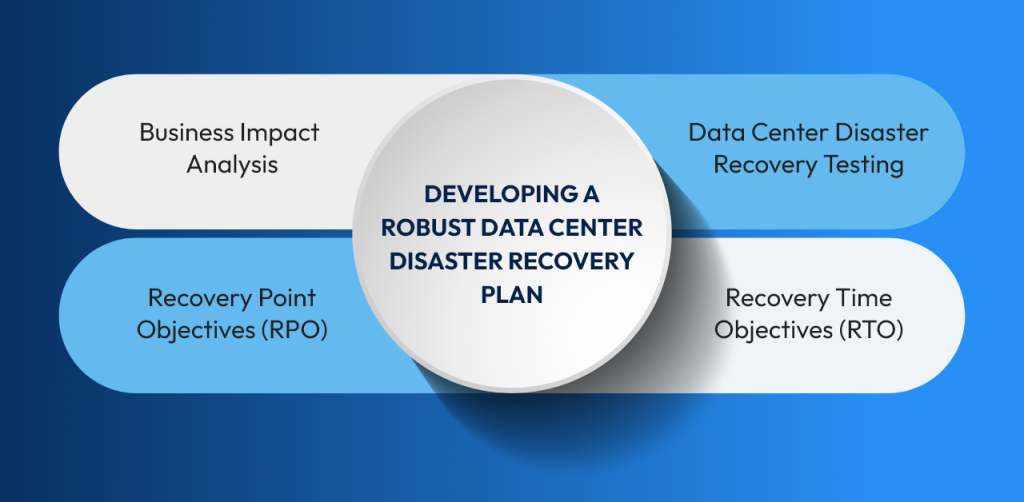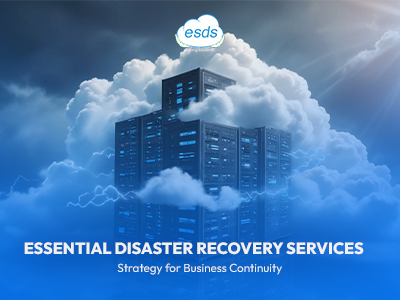Essential Disaster Recovery Services: Strategy for Business Continuity

Disaster recovery services for your data are a crucial system management component, whether you operate or use a service. Natural calamities, power outage issues, fires, and cyberattacks are the potential causes of data center outages and human errors, which rarely happen. With a plan to prioritize your most vital systems and recovery actions, you can avoid experiencing interruptions and downtime that may be disastrous for your organization. We’ll go over what a data center disaster recovery plan is, why it’s necessary in the first place, and three key components you’ll need in your approach.
What is a Disaster Recovery Plan?
A data center disaster recovery plan (DRP) is a structured plan that defines the processes to be followed in recovering lost data and restoring a company’s operations to normal after a disaster has occurred.
Why Is a Data Center Disaster Recovery Plan Essential?
A data center disaster recovery strategy protects your firm from unplanned downtime, irretrievable data, and even lost faith in your brand.
A well-designed data center disaster recovery strategy saves downtime, secures your data, enhances business continuity, and provides security and peace of mind. Furthermore, depending on regulatory requirements, your company may need to develop a DRP.
Calculating the Ideal Distance between Data Centers for Business Continuity
A key component of your disaster recovery strategy is selecting the best geographical locations for your data centers. A crucial part is setting up a ‘failback’ location that allows your systems to transition to the backup data center if the original site fails due to a natural catastrophe or other occurrence.
For disaster recovery, you should locate your data centers far enough apart that a natural disaster or large outage will not strike both facilities simultaneously. There is no hard and fast rule for this, but a decent recommendation is to keep the centers at least 100 miles apart.
Secure Uptime with a Data Center Disaster Recovery Plan
A data center disaster recovery strategy may help enhance uptime in various ways. Generally, a plan will contain a methodology for multiple backups, such as a primary data center and a secondary location or both on-premises and off-premises backups.
Preparing for data center disaster recovery also includes acquiring a better awareness of the hazards that may have a detrimental influence on uptime; for example, some large firms experience a total loss of $5 million per hour in unexpected downtime.
Developing a Robust Data Center Disaster Recovery Plan

A successful data center disaster recovery strategy must examine which business functions are most vital, how much downtime a company can tolerate, and how much data may be lost without significant ramifications. These may be determined by conducting a business impact study and determining the recovery time objectives (RTO) and recovery point objectives (RPO).
- Business Impact Analysis
A business impact study identifies essential systems and data that must be secured during a disaster. Business impact analysis helps to study the most important system and the data that needs to be protected during a disaster. In this way, organizations can understand which data needs to be safeguarded and assign such roles to persons who can handle such critical situations.
- Recovery Point Objectives (RPO)
Some organizations can afford to lose a day’s worth of data, while others can only spare a few minutes. An RPO is a target determined by the greatest quantity of data that a company can afford to lose. Depending on the type of data and the company’s nature, this might be measured in minutes, hours, or days.
- Data Center Disaster Recovery Testing
You must ensure your recovery strategies work if and when a crisis occurs. Disaster Recovery testing may help you uncover holes in your preparation, teach your disaster recovery team what to do in a real-world event, and keep everything up to date. Full-scale testing should occur at least once a year.
- Recovery Time Objectives (RTO)
A recovery time objective represents the target time for restoring systems once they have been interrupted. This is a fantastic time for a firm to need crucial systems and data. Some firms can last longer without their systems than others. Retail and smaller firms, for example, can often tolerate more extended periods of downtime than financial institutions or significant e-commerce businesses.
Disaster Recovery Statistics You Need to Know
According to Think Teal, 40 percent of Indian enterprises do not have a business continuity and disaster recovery strategy. Of those who do, almost half evaluate or revisit it once every three years, and just 31% provide regular staff training in this area.
Furthermore, 57% of respondents stated that their company attempted to achieve ‘cyber resiliency.’ Yet, fewer than 10% claimed that their business continuity and disaster recovery plan aligned with their cyber resiliency target.
Conclusions are drawn from interviews with more than 220 CIOs and IT decision-makers of large companies, which have been part of Think Teal’s ‘2024 State of BCDR, India study. The points concluded as below – what types of disasters Indian companies fear the most:
- Cyberattacks: 79%.
- Employee negligence: 61 percent.
- Natural calamities: 51%
- Geopolitical crisis: 49%.
- Hardware failure rate: 43%.
- Power outages: 37%.
How to Choose a Data Center with Disaster Recovery?
Choosing a data center with disaster recovery services and business continuity as top priorities is important.
To ensure security and compliance, ESDS implements controls, creates automated systems, and submits to the most trustworthy third-party auditors. Most of India’s stringently regulated corporations, banks, and government agencies rely on ESDS data centers. We protect the data of millions of active monthly users with seven levels of security infrastructure facilities. Some of India’s most valued corporations trust ESDS; banks, government departments, and enterprises may be hesitant for their employees, but they believe in the Fully Managed Data Center Co-location solution of ESDS.
- Understanding Private Cloud Services in Enterprise IT Environments - April 17, 2025
- Why Do You Need Vulnerability Assessment and Penetration Testing? - March 13, 2025
- How to Choose the Right Private Cloud Service Provider in 2025? - February 27, 2025
